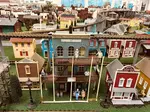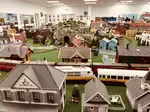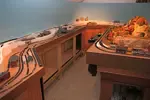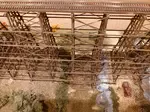 |
Building Your Model Railroad Blog
Building Your Model Railroad Blog
This is the official BYMRR Model Railroad Blog Page containing many excellent articles all about model railroading - train tutorials, modeling tips and techniques, layout scenery, wiring your railroad, automating your trains, building your layout benchwork, operating your trains and and links to model railroading supplies. Written by model railroad authorities on how to build a layout step-by-step.

To subscribe to this train blog, simply go to your favorite RSS reader and copy and paste this link into the proper feeder URL and you will immediately get all the updates on the newest model railroading tools, techniques and supplies...
https://www.building-your-model-railroad.com/model-railroad.xml
Contributions to this blog are very much encouraged and will be accepted after approval by the moderator. You may include a reference to your own website if it is related to model railroading or railfanning. Include photos whenever possible. You may also include train products that you would like to sell.
To sell products on this site, you must first go to the Classified Page and enter your information, product and price.
Please remember that all submissions to this blog must be in good taste and must be about trains, railroads, model railroads, railfanning, model structures, etc. All other entries will not be permitted.
The mission and goal of this model railroad blog is to enable interaction among model railroaders everywhere, to share information about the hobby to all those who are interested and to promote model railroading as a fantastic, enjoyable, artistic craft that enhances comradery and brings people together. You may also wish to check out our Blogspot on social media.
New and Updated Pages:
Dec 16, 2025
Model Railroad Supplies
We have started a new store to help you build your layout and teach your youngsters about science with STEM products.
Mar 09, 2025
DC and/or DCC on the Same Layout
How to wire your layout for either DC and/or DCC operation.
Nov 24, 2024
Looking for a locomotive speaker
First Name: RandyE-Mail Address: bymrr@building-your-model-railroad.comEnter your question: : I am looking for a speaker for a Walthers EMD SD70ACE Locomotive, product number 910-9866. The control board has a connector that seems unique to Walthers. I have found a speaker that fits the install location (Digitrax SP26158BC) but the plug is a bit larger than the receptacle on the control board. I have submitted queries to Walthers but have received no replies in almost 2 weeks. I have also contacted Digtrax and Midwest Model RR but neither has offered anything helpful. Anyone have an answer to this dilemma?
Jun 04, 2023
Tracks June 2023
Model railroading newsletter with lots of tips and tricks to improve your skills and help you enjoy the hobby.
May 22, 2023
Tracks - May 2023
Model railroading newsletter with lots of tips and tricks to improve your skills and help you enjoy the hobby.
May 20, 2023
Florida East Coast Red (not rust) Ortner Cars - paint color?
Hi All - I'm modeling the Cemex South Florida quarry. I'm modeling the FEC ortner cars from the 1980's/90's. I'm building the cars myself and have gotten
Continue reading "Florida East Coast Red (not rust) Ortner Cars - paint color?"
May 20, 2023
Vartak
I have a large collection of Marklin HO Trains of the era 1956 to 1980. I have two Hornby Dublo trains too. I was delighted to learn that you are an avid
Apr 02, 2023
Tracks - April 2023
Here is the April edition of Tracks, containing lots of information, tips and tricks for model railroaders of all ages and all gauges.
Mar 26, 2023
Train Photos
Gallery of prototypical and/or model train photos and model railroad layout photos
Mar 06, 2023
How to Handlay Model Railroad Track
If you're a model train enthusiast, you may be interested in learning how to handlay HO scale track. Handlaying track allows you to create a more realistic and customized layout than using pre-made track pieces. Here are some steps to get you started:
Gather your materials. You'll need HO scale track (ties, rails, and spikes), a track gauge, rail cutters, pliers, a soldering iron, flux, solder, a track template or plan, and a work surface.
Cut the ties. Lay out the ties in the correct spacing and cut them to the correct length using rail cutters.
Lay the rails. Using the track gauge, lay the rails on the ties in the correct position. Make sure the rails are straight and level.
Spike the rails. Using a small hammer and spikes, secure the rails to the ties. Be sure to space the spikes evenly along the rails.
Solder the rails. Apply flux to the joint where the rails meet and solder them together with a soldering iron. Be careful not to let the solder run onto the rails or ties.
Test the track. Once you've completed a section of track, test it with a locomotive and some rolling stock to make sure everything runs smoothly.
Repeat. Continue laying and soldering sections of track until you've completed your layout.The same instructions would also apply to any gauge. You would just have to use different-sized materials that would be appropriate for your gauge.
Handlaying track takes time and patience, but the result is a realistic and customized layout that you can be proud of. Don't be afraid to experiment with different track configurations and details to make your layout unique.
The following link provides purchasing options for the materials you need to handlay tracks and turnouts.
Mar 04, 2023
Tracks: February 2023
Model railroading newsletter with lots of tips and tricks to improve your skills and help you enjoy the hobby.
Mar 02, 2023
Tracks March 2023
The official newsletter of Building Your Model Railroad with tips, tricks, videos and how-to information that you can apply to your own railroad modeling.
Feb 04, 2023
Mountainous Layout Without Grades
One way to create a mountainous layout without requiring steep grades is to lay your track flat on 4-inch risers. You could even have one mainline on the layout surface and a second mainline on the 4-inch risers. This would give you the opportunity to easily create bridges, cliffs, and river gorges. You could build mountains above the risers and valleys below.
Feb 03, 2023
Make a Pond for Your Model Railroad
Choose the right material: A popular choice for creating water effects is clear silicone rubber, which can be tinted with food coloring to create different water hues.
Prepare the surface: Clean the area where you want to place the water and apply a layer of white glue to create a smooth surface.
Tint the silicone: If desired, add food coloring to the silicone to create the desired water hue. You can also add a drop of blue or green food coloring to simulate depth.
Pour the silicone: Pour the silicone rubber onto the surface, using a palette knife or similar tool to spread it evenly.
Create surface texture: To add realism to the water, use a toothbrush or similar tool to create ripples and waves on the surface of the silicone.
Allow to cure: Allow the silicone to cure completely, following the manufacturer's instructions.
Finish the edge: Once the silicone has cured, use a hobby knife or similar tool to trim the edge to create a natural-looking shoreline.
Apply any final touches: For added realism, you can add foam to simulate whitecaps. Add rocks, tall grass, and other scenery elements to the shoreline.
Jan 29, 2023
How to Install a DCC Decoder in an N Scale Locomotive
Installing a DCC decoder in an N Scale locomotive can open up a world of possibilities when it comes to customizing your model railway. With a Digital Command Control (DCC) decoder, you’ll be able to control the speed, direction, and lighting of your locomotives with precision accuracy. In this blog post, we’ll take a look at how to install a DCC decoder in an N Scale locomotive.
Before you begin installing the decoder, it’s important to make sure that you have all the necessary tools and materials on hand. You will need: an insulated Phillips-head screwdriver; tools for removing screws from the locomotive shell; needle nose pliers; soldering equipment including wire clippers and solder; flathead screwdrivers in various sizes; and Model Railroading DCC Decoder Installation instructions.
Once you have all the necessary tools and materials ready to go, the next step is to remove the body shell from your N Scale locomotive. This can typically be done by unscrewing four or five screws around the perimeter of the body shell. Once this is done, locate the motor as well as any existing wiring harnesses that are connected to it. Carefully disconnect any wires by using needle nose pliers to release them from their connectors.
Now that everything is disconnected, it’s time to install the DCC decoder into your N Scale locomotive. Begin by connecting one end of your new wiring harness into place on top of the motor. Then connect the other end of your new wiring harness onto your chosen DCC decoder - making sure all connections are secure before proceeding further.
Use soldering equipment to attach each wire from both ends of your wiring harness onto specific terminal points on each side of your DCC decoder - making sure that you refer back to Model Railroading DCC Decoder Installation instructions if needed for exact details on where each connection should go.
When everything has been connected properly and securely, use flathead screwdrivers in various sizes depending on which type of mounting option you wish to use when reattaching your body shell - ensuring that all screws are tightened securely before proceeding further with testing out how well everything works!
Finally, once everything is installed correctly and securely, refer back to Model Railroading DCC Decoder Installation instructions one last time so as to program any desired settings into memory such as speeds and lighting effects etc., in order for these settings now being programmed into memory actually take effect once powered up via track power later on!
With that said, installing a Digital Command Control (DCC)decoder in an N Scale locomotive can greatly expand upon what kind of customizations are now possible - allowing for maximum control over speed & direction along with lighting effects etc., offering many more possibilities when it comes customizing your locomotive operation.
Jan 01, 2023
Tracks: January 2023
2023 New Year's Edition of Tracks, a favorite newsletter for beginners and experts.
Dec 24, 2022
Merry Christmas!!

To all who love Christmas and Trains and to all their families and friends, Merry Christmas, and may the Joy and the Spirit of the Season be upon you all, now and throughout the New Year!
Dec 22, 2022
Troubleshooting Your Model Railroad
Troubleshooting your model railroad is just as much a part of model railroading as building the train layout. There will always be something that needs fixing.
Dec 11, 2022
New RSS Board for Model Railroading
If you like to use RSS feeds to keep up to date on all topics related to model railroading, here is a link to one that we set up...
Just copy this link into your favorite RSS reader and enjoy the updates.
Dec 11, 2022
Looking for MTH service or repair?
Check out the website at https://coltrains.com/ (Central Operating Lines Model Railroad Club)
Dec 05, 2022
Model Railroading Questions and Answers
Answers to questions about model railroading submitted by our readers
Dec 03, 2022
Tracks: December 2022
Tracks is a free model railroad newsletter containing lots of tips, tricks and techniques to help you in building your model railroad.
Nov 24, 2022
Happy Thanksgiving!!
Thanks to all the model railroaders and other visitors who make this site possible. Best wishes to all for a very happy and joyful Holiday Season!
Nov 13, 2022
Tracks: July-Aug 2021
Now a bimonthly newsletter for all those who enjoy the art and craft of model railroading with new tips, techniques and videos
Nov 13, 2022
Tracks: April 2021
The April issue of Tracks is once again full of model railroading information, pictures and videos for all ages and all scales.
Mar 01, 2022
Tracks: March-April 2022
A model railroad newsletter published by Building Your Model Railroad containing lots of tips, tricks and short articles related to model railroading.
Jan 02, 2022
Tracks January - February 2022
Tracks is a model railroading newsletter full of tips and techniques to help you learn more about America's favorite hobby.
Nov 05, 2021
Tracks November-December 2021
This issue of Tracks celebrates November as Model Railroading Month and encourages all model railroaders to spread the word about the world's greatest hobby.
Oct 14, 2021
Railroad Networks of the World
Railroad Networks of the World
If you are looking for a prototypical railroad upon which to base your layout design, you may want to consider using a combination of two resources. The first is to locate the railroad network in which you are interested at openrailwaymap.org. There you can see the entire network of your railroad. After that, you can choose particular points along that network and find them on Google Earth so you can zoom in on specific hubs, yards, and surrounding buildings.
Back to Home Page
Contact Me | Blog | Photos | References | Supplies | GiftShop | Sitemap | Search | Comment | Privacy Statement | Disclosures
Tracks Newsletter: Sign Up Here!
√ = ad or sponsored link
What's New on BYMRR.com?
Recent Articles
-
Model Railroad Supplies
Dec 16, 25 03:46 PM
We have started a new store to help you build your layout and teach your youngsters about science with STEM products. -
DC and/or DCC on the Same Layout
Mar 09, 25 10:46 AM
How to wire your layout for either DC and/or DCC operation. -
Looking for a locomotive speaker
Nov 24, 24 07:29 AM
First Name: Randy E-Mail Address: bymrr@building-your-model-railroad.com Enter your question: : I am looking for a speaker for a Walthers EMD SD70ACE Locomotive, product number 910-9866. The control b…
























